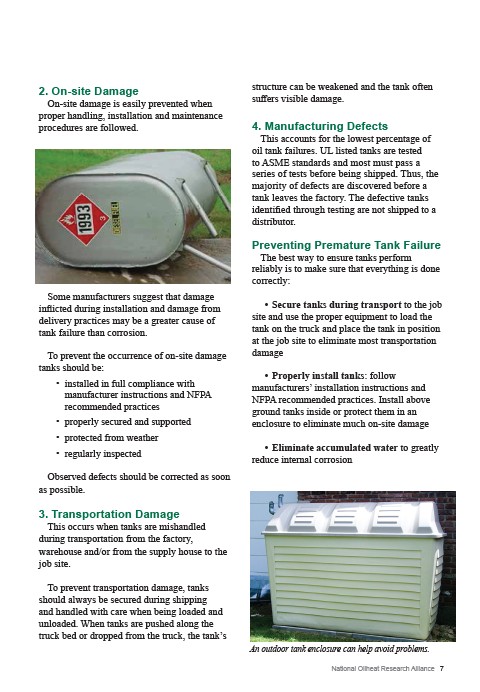
National Oilheat Research Alliance 7
2. On-site Damage
On-site damage is easily prevented when
proper handling, installation and maintenance
procedures are followed.
Some manufacturers suggest that damage
inflicted during installation and damage from
delivery practices may be a greater cause of
tank failure than corrosion.
To prevent the occurrence of on-site damage
tanks should be:
• installed in full compliance with
manufacturer instructions and NFPA
recommended practices
• properly secured and supported
• protected from weather
• regularly inspected
Observed defects should be corrected as soon
as possible.
3. Transportation Damage
This occurs when tanks are mishandled
during transportation from the factory,
warehouse and/or from the supply house to the
job site.
To prevent transportation damage, tanks
should always be secured during shipping
and handled with care when being loaded and
unloaded. When tanks are pushed along the
truck bed or dropped from the truck, the tank’s
structure can be weakened and the tank often
suffers visible damage.
4. Manufacturing Defects
This accounts for the lowest percentage of
oil tank failures. UL listed tanks are tested
to ASME standards and most must pass a
series of tests before being shipped. Thus, the
majority of defects are discovered before a
tank leaves the factory. The defective tanks
identified through testing are not shipped to a
distributor.
Preventing Premature Tank Failure
The best way to ensure tanks perform
reliably is to make sure that everything is done
correctly:
• Secure tanks during transport to the job
site and use the proper equipment to load the
tank on the truck and place the tank in position
at the job site to eliminate most transportation
damage
• Properly install tanks: follow
manufacturers’ installation instructions and
NFPA recommended practices. Install above
ground tanks inside or protect them in an
enclosure to eliminate much on-site damage
• Eliminate accumulated water to greatly
reduce internal corrosion
An outdoor tank enclosure can help avoid problems.